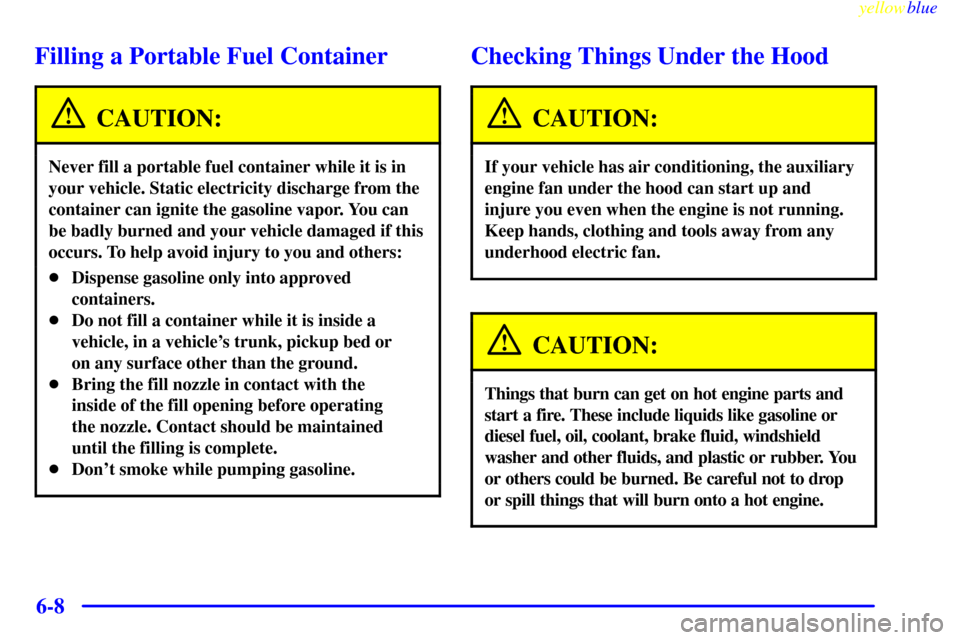Page 152 of 424

yellowblue
2-82 Fuel Gage
When the ignition is on, the
fuel gage tells you about
how much fuel you have
left in your tank.
The gage will first indicate E (empty) before you are out
of fuel, and you should get more fuel as soon
as possible.
Listed are four situations you may experience with your
fuel gage:
�At the gas station, the fuel pump shuts off before the
gage reads F (full).�It takes a little more or less fuel to fill up than the
fuel gage indicated. For example, the gage may have
indicated the tank was half full, but it actually took a
little more or less than half the tank's capacity to fill
the tank.
�The gage moves a little when you turn a corner or
speed up.
�The gage doesn't go back to E (empty) when you
turn off the ignition.
None of these indicate a problem with the fuel gage.
For information on how to fill your fuel tank, see
ªFuel
-- Filling Your Tankº in the Index.
For your fuel tank capacity, see ªFuel
-- Tank Capacityº
in the Index.
For the diesel engine fuel gage, see your Diesel
Engine Supplement.
Page 288 of 424

yellowblue
6-8
Filling a Portable Fuel Container
CAUTION:
Never fill a portable fuel container while it is in
your vehicle. Static electricity discharge from the
container can ignite the gasoline vapor. You can
be badly burned and your vehicle damaged if this
occurs. To help avoid injury to you and others:
�Dispense gasoline only into approved
containers.
�Do not fill a container while it is inside a
vehicle, in a vehicle's trunk, pickup bed or
on any surface other than the ground.
�Bring the fill nozzle in contact with the
inside of the fill opening before operating
the nozzle. Contact should be maintained
until the filling is complete.
�Don't smoke while pumping gasoline.
Checking Things Under the Hood
CAUTION:
If your vehicle has air conditioning, the auxiliary
engine fan under the hood can start up and
injure you even when the engine is not running.
Keep hands, clothing and tools away from any
underhood electric fan.
CAUTION:
Things that burn can get on hot engine parts and
start a fire. These include liquids like gasoline or
diesel fuel, oil, coolant, brake fluid, windshield
washer and other fluids, and plastic or rubber. You
or others could be burned. Be careful not to drop
or spill things that will burn onto a hot engine.
Page 344 of 424
yellowblue
6-64
Name Circuits Protected
ECM
-B Fuel Pump, PCM/VCM
RR DEFOG Rear Window Defogger
(If Equipped)
IGN
-E Auxiliary Fan Relay Coil, A/C
Compressor Relay, Hot Fuel Module
FUEL SOL Fuel Solenoid (Diesel Engine)
GLOW PLUG Glow plugs (Diesel Engine)
HORN Horn, Underhood LampsName Circuits Protected
AUX FAN Auxiliary Fan
ECM
-1 Injectors, PCM/VCM
HTD ST
-FR Heated Front Seats
A/C Air Conditioning
HTD MIR Heated Outside Mirrors (If Equipped)
ENG
-1 Ignition Switch, EGR, Canister
Purge, EVRV Idle Coast Solenoid,
Heated O
2, Fuel Heater
(Diesel Engine), Water Sensor
(Diesel Engine)
HTD ST
-RR Not Used
LIGHTING Headlamp and Panel Dimmer
Switch, Fog and Courtesy Fuses
BATT Battery, Fuse Block Busbar
IGN
-A Ignition Switch
IGN
-B Ignition Switch
ABS Anti
-Lock Brake Module
BLOWER Hi Blower and Rear Blower Relays
STOP/HAZ Stoplamps
HEATED SEATS Heated Seats (If Equipped)